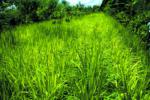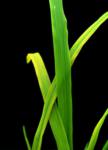Iron deficiency
What it does
Iron deficiency affects photosynthesis and leads to reduced yield and dry matter production.
Why and where it occurs
Fe deficiency is relatively rare, especially in irrigated rice systems.
Soils particularly prone to Fe deficiency include are:
- neutral, calcareous, and alkaline upland soils
- akaline and calcareous lowland soils with low organic matter status
- lowland soils irrigated with alkaline irrigation water
- coarse-textured soils derived from granite
How to identify
Check the plant for the following symptoms:
- Interveinal yellowing and chlorosis of emerging leaves
- Whole leaves become chlorotic and then very pale
- Entire plant becomes chlorotic and dies if deficiency is very severe
- Decreased dry matter production
To confirm iron deficiency, send soil and plant sample to lab for Fe deficiency test.
Click on images to enlarge
How to manage
- Grow Fe-efficient cultivars
- Apply organic matter (e.g., crop residues, manure)
- Apply waste materials from mining and other industrial operations provided that they do not contain other pollutants at toxic concentrations
- Use acidifying fertilizers (e.g., ammonium sulfate instead of urea) on high-pH soils
- Use fertilizers containing Fe as a trace element
Learn more
View full fact sheet:
Iron deficiency on IRRI Rice Knowledge Bank
© Copyright 2014. All rights reserved.



